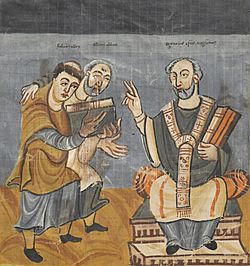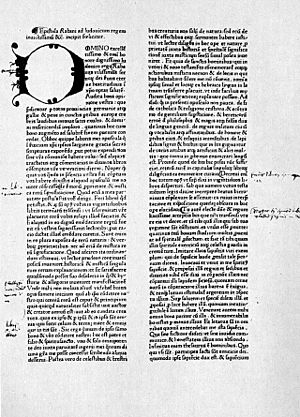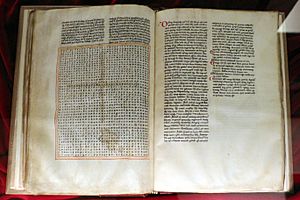Rabanus Maurus facts for kids
Quick facts for kids SaintRabanus Maurus |
|
|---|---|

Rabanus Maurus (left) with Alcuin presents his work to Otgar of Mainz (right). Illustration from a Fulda manuscript, c. 830–840.
|
|
| Archbishop of Mainz, Monk | |
| Born | c. 780 Mainz |
| Died | 4 February 856 Winkel |
| Venerated in | Catholic Church |
| Feast | 4 February |
| Influences | Alcuin |
Rabanus Maurus Magnentius (around 780 – 4 February 856) was a very important Frankish scholar. He was a Benedictine monk, a theologian (someone who studies religion), a poet, and a writer who created an encyclopedia. He later became the archbishop of Mainz in a region called East Francia.
Rabanus Maurus wrote a famous encyclopedia called De rerum naturis, which means "On the Natures of Things." He also wrote books about education, grammar, and detailed explanations of the Bible. He was one of the most influential teachers and writers during the Carolingian age. People called him "Praeceptor Germaniae," meaning "the teacher of Germany." Today, he is recognized as a saint in the Catholic Church, and his feast day is on February 4.
Contents
The Life of Rabanus Maurus
Rabanus was born into a noble family in Mainz. We don't know his exact birth year. In 801, he became a deacon (a church official) at the Benedictine Abbey of Fulda in Hesse. He had been sent there for school and had become a monk.
His abbot, Ratgar, sent him to study more in Tours. There, he learned from a famous scholar named Alcuin. Alcuin was so impressed by Rabanus's hard work that he gave him the nickname "Maurus." This name was after Saint Maurus, a favorite student of Benedict of Nursia.
Leading the Fulda School
After returning to Fulda in 803, Rabanus took charge of the abbey school. Under his leadership, the school became one of the best places for learning and making books in Europe. Many important students, like Walafrid Strabo and Servatus Lupus, studied there. During this time, he likely put together a popular textbook on grammar. It is said that Rabanus was very disciplined, eating no meat and drinking no wine.
In 814, Rabanus became a priest. He left Fulda for a short time due to a disagreement with the abbot. He returned in 817 when a new abbot, Eigil, was chosen. When Eigil died in 822, Rabanus himself became the abbot. He managed the abbey very well. In 842, he decided to step down from his role to have more time for studying and prayer. He moved to a nearby monastery called St Petersberg.
Becoming Archbishop
In 847, Rabanus was asked to return to public life. He was chosen to become the Archbishop of Mainz, taking over from Otgar. He passed away in Winkel on the Rhine in 856.
Famous Hymns by Rabanus
Rabanus Maurus wrote several hymns, which are religious songs. His most famous hymn is Veni Creator Spiritus. This hymn is dedicated to the Holy Spirit. It is often sung during Pentecost (a Christian holiday) and at ceremonies where people become priests.
You might know it by its English names, like "Come, Holy Ghost, our souls inspire" or "Creator Spirit, by whose aid." A famous composer named Gustav Mahler even used Veni Creator Spiritus in his eighth symphony.
Another hymn by Rabanus is "Christ, the fair glory of the holy angels." This song is sung to honor Saint Michael and All Angels. It also includes the archangels Gabriel and Raphael.
Important Writings and Works
Rabanus Maurus wrote many books and commentaries. Many of his works were explanations of different parts of the Bible. He also wrote about important religious and practical topics.
Books on Education and Knowledge
In his book De institutione clericorum, Rabanus wrote about the importance of good training for church leaders. He shared ideas from earlier thinkers like Augustine and Gregory the Great.
One of his most popular works is a collection of poems about the cross. It's called De laudibus sanctae crucis or In honorem sanctae crucis. These poems are very clever, using words, pictures, and even numbers to show the cross.
His book De universo libri xxii., sive etymologiarum opus was like a huge dictionary or encyclopedia. It was based a lot on Isidore of Seville's Etymologies. Rabanus created it to help people understand the Bible in different ways: historically, symbolically, and mystically. He also wrote about church rules and a list of saints. Rabanus was known for his great knowledge, even knowing some Greek and Hebrew. He also updated a book on military tactics to help improve Frankish warfare.
Runes and Language Studies

Rabanus is also linked to a special runic alphabet found in a book called De Inventione Litterarum. Runes are ancient letters used in some Germanic languages. This alphabet was a mix of different runic styles. It was found in old manuscripts from the 8th and 9th centuries.
The book said these runes belonged to the "Marcomanni," but they were actually an attempt by scholars to create runic letters for every letter in the Latin alphabet. A scholar named Wilhelm Grimm studied these runes in 1821.
Remembering Rabanus Maurus
In 2006, people in Germany celebrated the 1150th anniversary of Rabanus Maurus's death. Special events took place in Mainz and Fulda. One highlight was a rare display of an old manuscript containing his De laudibus sanctae crucis. This manuscript was loaned by the Vatican to Mainz. The anniversary also led to the publication of several new books about Rabanus and his work.
See also
 In Spanish: Rabano Mauro para niños
In Spanish: Rabano Mauro para niños



